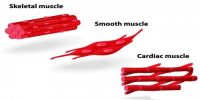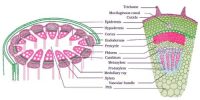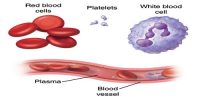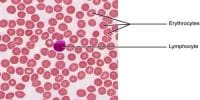Due to the formation of secondary tissues in the intra-stelar region, substantial pressure is exerted on the epidermis which becomes prolonged and tends to rupture. Secondary growth of the Dicot Stem takes place in extra stelar area due to the function of cork cambium and related issue. Generally, Cork cambium is also known as Phellogen or Extra stelar cambium in biology study.
A plant whose seed contains two cotyledon or embryonic leaf is known as a dicot. This article briefly focuses on characteristics and anatomy of dicot stem.
Extra-stelar secondary growth of the dicot stem is discussed below under the two headings:
Formation of periderm:
(i) At the advent of extra-stelar secondary growth, the cells of the outer most layer of the hypodermis turn into phellogen or cork cambium after having incapable of cell division.
(ii) The cells of the phellogen or cork cambium undergo division and form cork cells or phellem towards the peripheral region and phelloderm or secondary cortex towards the inner side. When one cork cambium causes its function, another new one appears in the inner tissues.
(iii) Cork-cambium cells divide as usual forming parenchymatous phelloderm or secondary cortex on the inner side and cork cells or phellem on the outer side. Cork cambium generally occurs from the hypodermis or from the outside layer of cortex because they become meristematic. Cork cells are brick-shaped ones which lose protoplasm and their walls are suberised.
(iv) Cork cambium is also produced in the shape of a single-layered ring. It forms sec. the tissue in the cortical region. It produces few cells towards the outer (epidermis) and few cells towards the inner (cortex). Those cells formed towards outside, their middle side lamella is suberized and formed. Due to this, these cells become dead. These cells are generally known as Cork or Phellem,
Formation of bark:
(i) Due to the presence of subenn in the walls of cells water cannot enter into them.
(ii) As the cork cells do not get any Supply of water and food from the inner conducting tissue, they gradually dry up and die and the cells are commonly known as bark ‘finis, the dead cells from a hard layer around the stem “Ibis hard wet which Is formed outside the cork cambium or phellogen is known us bark.
(iii) These suberised cork cells serve as secondary protective tissues. But as they are impervious to water, the cells lying outside the cork do not get any supply of food. They ultimately die and dry up to form what is known as bark. A continuous bark is called ring bark; but if the bark is formed in patches, as in guava, it is called scale bark.
The bark is of two types, such as- Scally hark- Guava, Pins plant, etc
Ringed bark- Mango, lichi, etc.
Functions and occurrences –
- It protects the plant from the excessive heist and cold,
- It generally occurs in the extra stelar area after stelar secondary growth begins,
- It reduces the rate of evaporation,
- Generally occurs by the forms of cork cambium,
- It protects the inner tissues from dryness,
- Usually produces cork cells and parenchyma cells in plants,
- It protects the inner tissues from external hurt and the attack of fungi and bacteria,
- Usually, these are no annual ring formation happens,
- It also gives a little mechanical support,
- Leads to the formation of periderm and lenticels,
- Generally produces protective tissues outside the plants.














